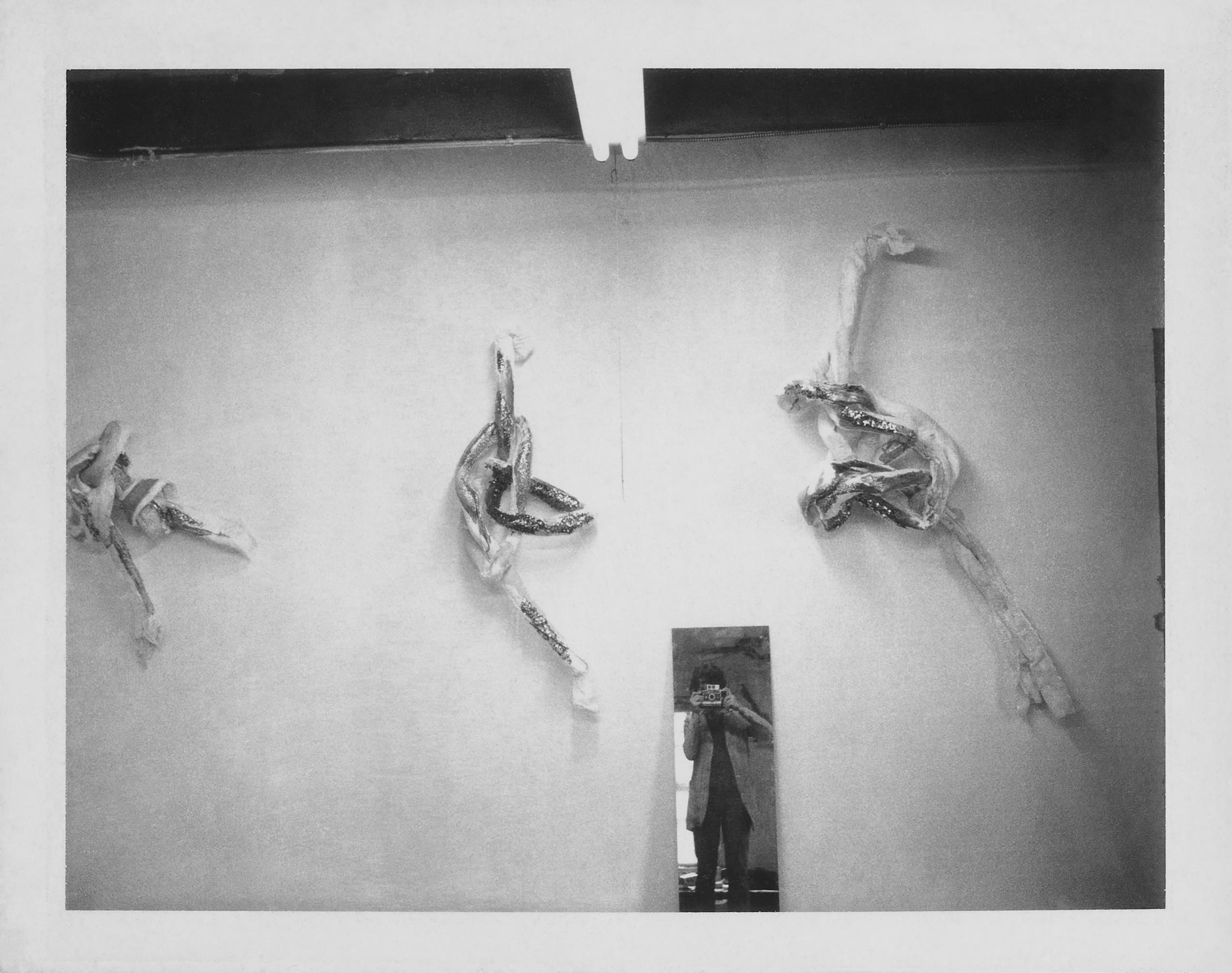Lynda Benglis 8 May - 27 Jul 2024 11 Duke Street, St James's
Private view: Tuesday 7 May, 6–8pm
Thomas Dane Gallery
11 Duke Street, St James’s, London SW1
In May 2024, Thomas Dane Gallery will present two seminal groups of works by Lynda Benglis (b. 1941, Lake Charles, Louisiana). Exhibited together here, decades after they were first seen in the U.S., Benglis’s knotted sculptures and videos from 1972 to 1976 show more unaltered exuberance and enduring adventure than ever.
The first half of the seventies saw Benglis wrestle with the hard-edge aesthetics of the sixties, distorting its orthodox forms and ideologies—scrunching, twisting and knotting them up. Freezing these tussles in time, Benglis embellishes each of her “knots” with sparkles, plaster and paint, or even sprays them with metallic coatings.
It is easy to see the progression from Hoofers I & II (1972)to the “knots” proper, as Benglis starts to contort and experiment with her materials, beginning with long tubular pieces of wire mesh covered with cotton bunting and plaster, twisting and tying these forms before adorning them with paint, glitter and other decorative materials. Synthesising her own encounters with Barnett Newman’s “zip” paintings and Here sculptures, as well as Eva Hesse’s “anti-form” compositions, Benglis both absorbs and interrogates her artistic surroundings of the time.
Described in 1974 as “too garish to be pretty and too beautiful to be vulgar” by critic John Perreault, Benglis’s “knots” not only challenge the context of taste, but also stand in stark contradiction to the industrial methods of production employed by the likes of Donald Judd and Dan Flavin, which characterised prevailing minimalist aesthetics of the period.
In what is considered video’s “first decade”, Lynda Benglis began experimenting with the medium when she was teaching at the University of Rochester in upstate New York, and was one of few artists who were pushing the limitations of this new technology. While her knotted sculptures are dramatic and performative, her video pieces become contrarily paced and sculptural.
Benglis’s experimentations in moving image and sound, especially in the works brought together in this exhibition: Collage (1973), Now (1973), and Document (1972),are candid trials in layering space, image, and time. Benglis layers and re-layers the image of her own face, pushing and pulling focus between the background and the foreground, and playing with the different levels of reality embedded into the videotape. Within the screen, the Self becomes trapped in a timeless state of repetition.
Although Benglis’s oeuvre to date is inherently self-referential, Home Tape Revised (1972) is probably one of the most overtly autobiographical works exhibited. In this video, Benglis documents her family on a visit back to Louisiana. She then recorded herself revisiting the footage and narrating—or revising—this intimate home video. The emotional distance of her soliloquy from inherent intimacy creates chasms of space and layers of interpretation upon the image within an image.
As true now as it was fifty years ago, Lynda Benglis’s explicitly psychical and physical processes stage her own body into a medium of its own; a medium which has endured decades beyond the technology of the era. Whether recorded on a videotape or impressioned into a knotted sculpture, her explorations of the Self in the years 1972–1976 were not only ahead of their time, but marked the beginning of her own pioneering career.
Since the 1960s, Lynda Benglis has been celebrated for her free, ecstatic forms that are simultaneously playful and visceral, organic and abstract. Benglis began her career in the midst of Postminimal art, pushing the traditions of painting and sculpture into new territories. Her work—comprised of a variety of materials, from beeswax, latex, and polyurethane foam to later innovations with plaster, gold, vaporised metals, glass, ceramics, and paper—demonstrates a continued fascination with process and experimentation. The embrace of flowing forms, colour and sensual surfaces plays a large part in her continuous investigation of sensory experience.
Selected institutional solo exhibitions include: Lynda Benglis, Nasher Sculpture Center, Dallas TX (2022); Lynda Benglis, National Gallery of Art, Washington, D.C. (2021); In the Realm of the Senses, Museum of Cycladic Art, presented by NEON, Athens, Greece (2019); Lynda Benglis: Face Off, Kistefos-Museet, Jevnaker, Norway (2018); Lynda Benglis: PRAXES at Bergen Assembly, Bergen, Norway (2016); Lynda Benglis, Aspen Art Museum, Aspen CO (2016); Lynda Benglis: Water Sources, Storm King Art Center, Mountainville NY (2015); Lynda Benglis, The Hepworth Wakefield, Wakefield, England (2015); Lynda Benglis: Flows and Marks, Kunstiftung Erich Hauser, Rottweil, Germany (2012), and Lynda Benglis, Van Abbemuseum, Eindhoven, Netherlands (2009) [travelled to: Irish Museum of Modern Art, Dublin, Ireland (2009); Le Consortium, Centre d’Art Contemporain, Dijon, France (2010); Museum of Art, Rhode Island School of Design, Providence RI (2010); New Museum of Contemporary Art, New York NY (2011); Museum of Contemporary Art, Los Angeles CA (2011)] among many others.
Selected public collections include: Tate Modern, London; Dallas Museum of Art, Dallas TX; Museum of Contemporary Art, Chicago IL; Museum of Contemporary Art, Los Angeles CA; The Museum of Modern Art, New York NY; Solomon R. Guggenheim Museum, New York NY; National Gallery of Victoria, Melbourne, Australia, among many others.
Benglis is the recipient of a Guggenheim Fellowship and two National Endowment for the Arts grants, among other commendations.
For exhibition and sales enquiries please contact Emma Da Costa: emma@thomasdanegallery.com
For press enquiries please contact Patrick Shier: patrick@thomasdanegallery.com

‘Sparkle knots’ in the artist’s Baxter Street studio, New York City, 1972 © Lynda Benglis. Licensed by VAGA at Artists Rights Society (ARS), NY. Photo: Lynda Benglis.
